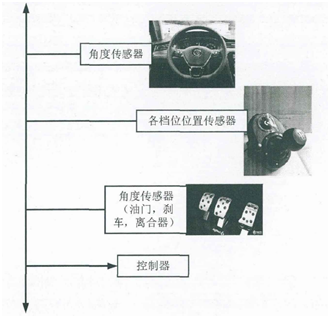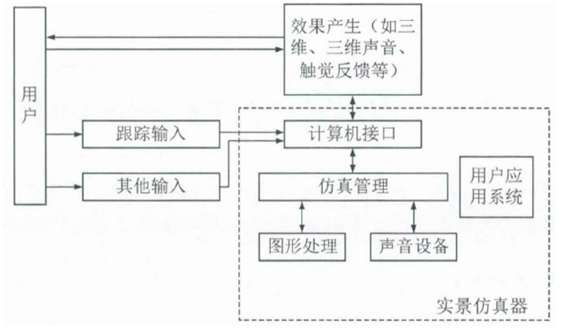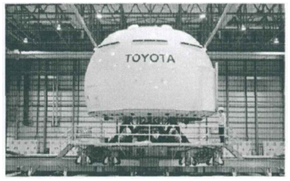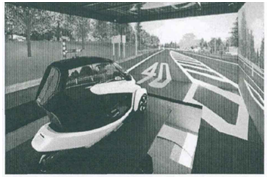The application of virtual Reality technology in vehicle driving training system - Dr. Hong Yue
2020-12-21
In the era of rapid development of national economy, people use more cars, and the traffic safety problem becomes more and more serious with the increasing number of motor vehicles. The increasing demand for car ownership leads to the rapid growth of the demand for driving training, which also puts forward higher requirements. The traditional driving training industry is facing great pressure and challenges. At present, the immersive virtual reality training system has been widely used in the field of driving skills training, and traffic safety education, in this way, based on the driving training has the advantages of convenient and quick, simple operation, but also able to realistic driving scene real training ground height reduction, effectively improving the efficiency of the students to learn driving skills and experience, it provides a new way for the car driving training industry.
1. Background
Driving school is to obtain a driver's license of the traditional way of training, but driving training quality is uneven, some driving a vehicle amount of tension, training time, training appointment difficult problems, such as, due to the driver's test registrations in huge, cluttered market, random charging phenomena to a certain extent helped exam-oriented training, training quality is difficult to guarantee. In order to cater to the market trend of increasing number of applicants year by year, training institutions tend to expand the enrollment of students, so there will be a shortage of coaches, limited space, huge loss of vehicles and other phenomena. The teaching method that should be one-to-one teaching guidance is broken, and one-to-two, one-to-many situation is common. In this case, the venue arrangement of driving practice for individual students is also shrinking, and the worry of poor teaching quality is imminent. With the significant increase of students, the utilization rate of vehicles keeps rising, vehicle repair and scrapping increase the investment cost of driving schools, and the pollution problem caused by fuel consumption is not to be underestimated. Therefore, to ensure the quality of teaching, ensure traffic safety, and even reduce the pollution problem of training vehicles, can be used in the field of driving training advanced technology, improve and optimize the vehicle driving training test. The driving system based on virtual reality technology has the following advantages:
(1) Broad application prospects
Traditional virtual driving technology can undoubtedly solve the problem that training time and place will be limited for various reasons. Its training process is simple and efficient, which not only is simple to operate, but also can save time for students. At the same time, as the price of the test hardware has been declining along with the development and improvement of science and technology, VR technology providing technical support has developed rapidly, and virtual driving test training will become a new revolution and mainstream in the field of driving training.
(2) the important academic value
It is of great significance to study drivers' behavior and character in driving to improve training effect, especially to ensure road safety. The real-time driving ability of the driver can be reflected to a certain extent from the state information of the vehicle. The samples of the experimental group determined the relevant standards of the benchmark driving ability in the collection and calculation. The evaluation of driving ability needs the reference of relevant standards, and the training effect can be evaluated by using the multi-reference standards. The comparison of reference standards can further standardize driving skills and driving habits. Other related fields can also learn from this solution on similar problems, which is conducive to the mutual communication and cross-integration between related fields and has a profound guiding significance for promoting the development of scientific research and innovation.
2. The combination of virtual reality technology and vehicle driving training system
Driving training system based on virtual reality technology, the combination of interactive technology, the scene simulation technology, 3 d display technology, not only can provide users with visual, auditory, and tactile perception, but also can realize the user and virtual scene of natural interaction, make driving environment can be similar to the real driving conditions height, the driver can see, hear and tactility is similar to normal driving average height, to achieve real sense of immersion. When designing the simulated driving system, we should first consider the following technical principles to be followed in the application of the project:
(1) Security: When interacting with the system, the experiencer needs to make some body movements. Therefore, the system should strictly follow the safety principles to ensure the overall safety of the system and the safety of the experiencer in the experience process.
(2) Stability: It is undeniable that if a system breaks during operation, the driving experience will be reduced, so we need the system to achieve the stability goal. It requires the system to be able to run continuously during the experience, and the platform will remain stable after the experience. It ensures the stable operation of a large number of experiencers.
(3) Practicality: The design of the system needs to meet the experience requirements of users, so that users can fully experience the practicality and authenticity of vehicle driving. The virtual reality scene should be beautiful, practical, simple and easy to operate, presenting users with a 360-degree driving simulation scene with no dead Angle.
(4) Advancement: The most advanced technology is adopted in the system method design, software and hardware selection, which not only ensures the reliability of the system functions, but also makes the overall level reach the leading level of domestic peers.
(5) Flexibility: The whole support platform of the system adopts the standard interface, which is easy to maintain and flexible to expand. Every part of the system is modular. When there is a problem with the system, the damaged module can be easily replaced and the system can be repaired in the shortest time.
In addition, as the main input device, the driving simulator is used to provide input signals for the virtual reality system and control the master vehicle, as shown in Figure 1. The input module mainly includes the following six aspects:
(1) Steering wheel. The motion direction of the vehicle in the virtual scene is controlled by the rotation Angle of the steering wheel. The steering wheel Angle is designed to be exactly the same as the real car simulation. It can rotate 1.5 times clockwise and counterclockwise.
(2) The accelerator pedal controls the speed of the vehicle in the virtual scene by adjusting the Angle of the accelerator pedal according to driving conditions;
(3) Clutch, auxiliary vehicle starting and shifting;
(4) The brake pedal controls the moving speed of the vehicle in the virtual scene by adjusting the Angle of the brake board;
(5) Shift the lever to control the forward and backward driving of the virtual vehicle by changing the gear;
(6) Hand brake to assist in slowing down and stopping.

FIG. 1 Schematic diagram of simulated frame
At present, virtual reality technology is relatively mature and widely used in many fields, and its effectiveness has been further proved in the application practice. Therefore, this paper is designed and developed based on virtual reality technology. Virtual reality is a computer technology as the core, the computer technology can handle all of the visual, auditory, tactile signal, and the signals produced by the information integration and processing, by controlling the related equipment can be natural and computer, and it can simulate the virtual computer communication object, interaction with computers is in the user view with a virtual objects communicate with each other, and can give you is the same in the real world. As shown in Figure 2, it is the general composition of virtual reality system.

Figure 2 General composition of virtual reality system
Virtual reality system is mainly the four main parts, the different part of the perform different functions system input and output part embodies the interaction process of information, tracking user action or behavior, turning it into computer software can handle input signal, so the task of software platform is the algorithm and program is used to calculate and analyze each input signal, the role of the 3 d model database is a constantly updating the database according to the control of software, choose to suit to show the user scene elements, and to ensure that users on the system design for output signal of the operation is very simple, on the design requirements, VR headsets or some 3D display devices are well suited for design choices.
(1) Input module: The driving training system designed in this paper includes multiple input channels, such as information collection of driving simulator, motion data capture of user's hand by motion-sensing interactive device and user's head collected by VR headset.
(2) Output module: The research purpose of virtual reality system is to understand and simulate some human organs. Action by equipment to give the user feedback, corresponding user operation can produce what kind of consequences in the case, what they'll hear and see what, or what touch, is to consider the output of the system design, so the 3 d stereo sound effects, image visual or tactile effect design processing sensitive and should be proper.
(3) virtual reality software platform, the virtual environment is all set to the user service, user's location changes or other action can change the Angle of the scene rendering, the corresponding database of data provides the simulation reality environment will also change, so the output of the related control begin from the input signal through the software platform is passed to the output device.
(4) 3D model database: The virtual objects of the system are all composed of a complete database, including relevant data sets such as shape, lighting, parameters, etc., but the operational data of each operator is different. As a result, the database information is constantly updated based on what the user is doing.
3. Research status of driving simulator at home and abroad
With the support of the rapid development of computer technology, ordinary computers can realize the virtual reality technology which can only be realized on the professional graphics platform before. The virtual driving training system mainly includes seven modules: virtual training scene, automobile power model, THREE-DIMENSIONAL display system, sound playing system, human-computer interaction system, automobile motion control module and evaluation module.
Foreign driving simulation technology initially available only to air driving training, the concept of driving simulation is also in the process have been proposed, with the development of related technologies and application market and rise, especially in Computer Graphic (Computer graphics) and its imaging science major scientific research achievements, make early is mainly used in aviation and important field of driving simulation technology can gradually applied to automobile driving training compared with domestic, abroad earlier research for development in the corresponding field, In addition, the research level has been ahead of that of developed countries such as Japan and Europe, which have invested a large amount of money in the research and development of driving simulator. They have approved the method of using driving training simulator to evaluate the driving ability of drivers, and legislated and regulated the use of the simulator. Japan and western European countries make use of legislation and funds to promote the rapid development of simulated driving technology. They apply driving simulation test to accident prevention, and use the same type of driving simulator to evaluate drivers' ability to deal with emergencies and avoid accidents. The driving simulator independently developed by Toyota Motor Corporation of Japan is shown in Figure 3. Driving and vehicle driving simulation are carried out in VR space. The realistic picture stereo vision creates the sense of reality of driving with its high-precision visual perception. With the combination of the small amplitude high-response electric motion platform system and the cockpit module hardware system, the first large driving simulator is integrated. The simulator uses a system that builds mathematical models to monitor human responses and perceptual characteristics. FIG. 4 is a highly realistic driving experience simulator launched by Toyota in Japan. At that time, it was at the top level in the world, laying the foundation for Toyota's leading position. This simulator realized the high simulation effect promised by customers and received very high user evaluation. In order to cater to the user's novel experience, the simulator is cartoon style, and even to make the user feel more immersed. In addition, the driving simulator is highly accurate to the driving control equipment, equipped with the same hardware as the real car, such as clutch, deceleration pedal and acceleration pedal. And the force feedback device is used to simulate the road sensation of different roads. The details are enough to show the attention of product developers.


FIG. 3 Posture simulator of A Toyota vehicle FIG. 4 Large 5 screen CAVE
At first, domestic automobile simulators could only introduce foreign ready-made equipment. The research on automobile simulators in China started late, developed slowly and was quite difficult. The earliest driving simulator introduced in China was imported from the Czech Republic. Its display mode is point light flat projection, which only provides a simple road plane scene without three-dimensional scene simulation of uphill or bridge crossing. It was not until 1970 that China began to enter the stage of independent research and development from the embarrassment of constantly introducing simulators, and designed and developed its own first car driving simulator, realizing a breakthrough from scratch. While Japan and Western Europe countries achieve the marketization of the simulated driving device, under the background of the study, the major research institutions and enterprises in our country began to invest huge energy research by using a driving simulator, which mainly includes the vehicle more leading professional and jilin university, tsinghua university and other famous universities, with the development of computer graphics and image at the same time, our country also has made remarkable progress in recent years, also in the field of driving simulation, a fruitful including a number of representative research achievements, such as computer imaging system MCGI - 9410 - t and QM - CUI driving simulator, The boom in the two products, designed and developed by Beijing Aerospace And Aviation Precision Research Institute respectively, has prompted a number of small and medium-sized companies, such as Beijing Yiai and Anhui Sanlian representative companies, to put their products on the market.
4. Research outlook
Virtual reality technology in the 21st century has developed mature, and applied to each big platform, the introduction of virtual reality technology in the field of driving training has become possible, VR technology to driving training exam added a new training method, the method through the interactive characteristics of VR technology, characteristics of immersion and imaginative features to help trainees to build realistic experience in training scenario. Head-mounted VR equipment can provide drivers with an immersive driving experience in terms of hearing, vision and touch, while the cost of the equipment is much lower than that of traditional driving training, which makes the application of head-mounted wearable devices in the field of virtual driving training greatly improved. The VR technology without field operation can simulate some dangerous scenes and avoid some unsafe hidden dangers caused by emergencies. Although the virtual driving model can solve some safety problems in the traditional driving test training, the shortcomings of the driving model itself still need to be improved. To sum up, the application of VR technology in driving training has a very broad prospect.
